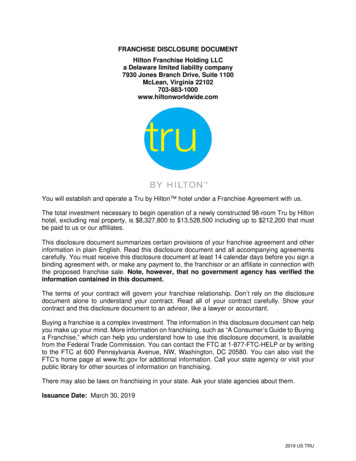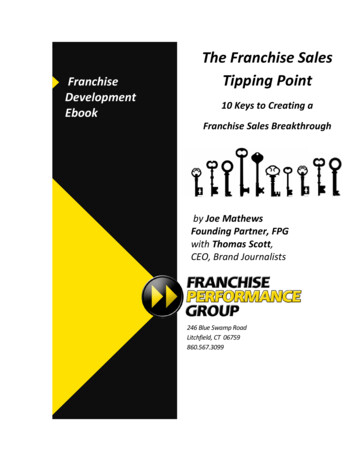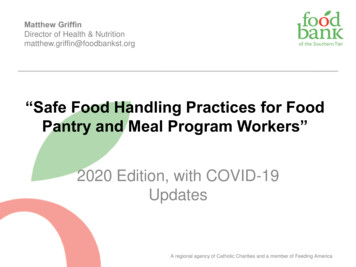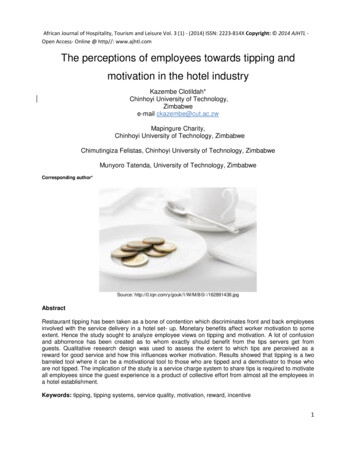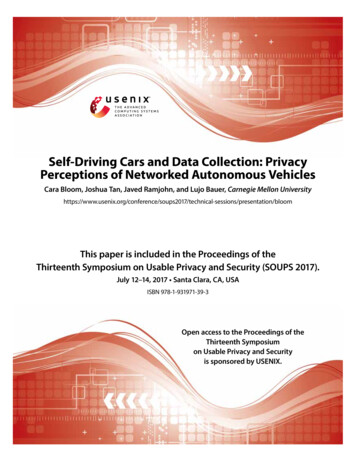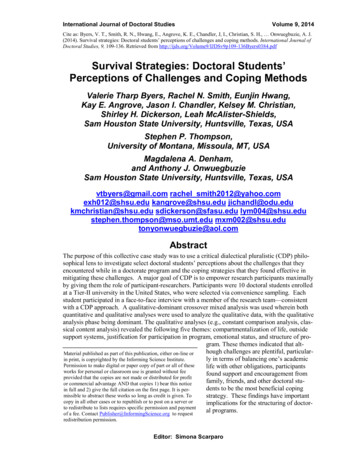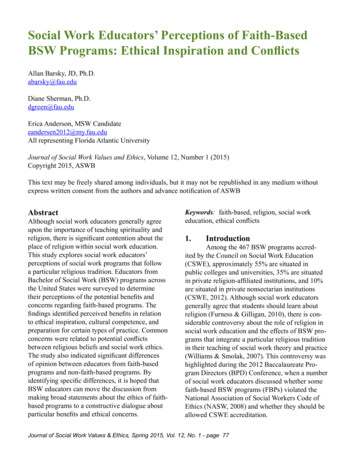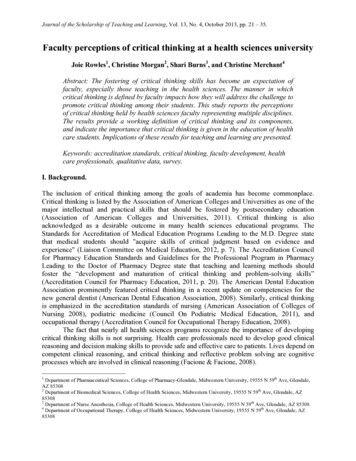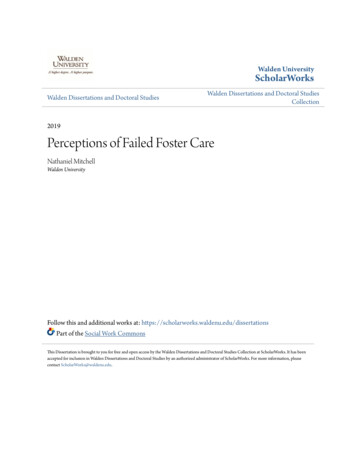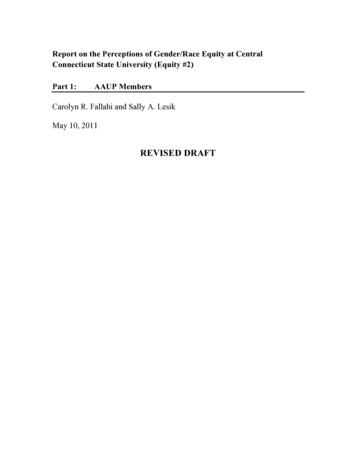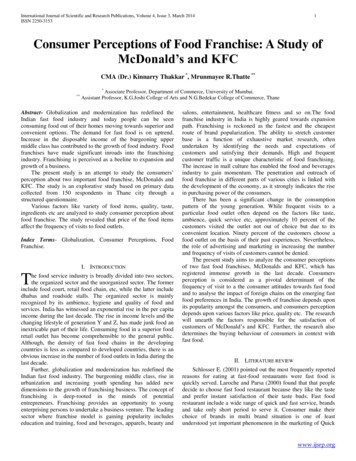
Transcription
International Journal of Scientific and Research Publications, Volume 4, Issue 3, March 2014ISSN 2250-31531Consumer Perceptions of Food Franchise: A Study ofMcDonald’s and KFCCMA (Dr.) Kinnarry Thakkar *, Mrunmayee R.Thatte *****Associate Professor, Department of Commerce, University of Mumbai.Assistant Professor, K.G.Joshi College of Arts and N.G.Bedekar College of Commerce, ThaneAbstract- Globalization and modernization has redefined theIndian fast food industry and today people can be seenconsuming food out of their homes moving towards superior andconvenient options. The demand for fast food is on uptrend.Increase in the disposable income of the burgeoning uppermiddle class has contributed to the growth of food industry. Foodfranchises have made significant inroads into the franchisingindustry. Franchising is perceived as a beeline to expansion andgrowth of a business.The present study is an attempt to study the consumers‟perception about two important food franchise, McDonalds andKFC. The study is an explorative study based on primary datacollected from 150 respondents in Thane city through astructured questionnaire.Various factors like variety of food items, quality, taste,ingredients etc are analyzed to study consumer perception aboutfood franchise. The study revealed that price of the food itemsaffect the frequency of visits to food outlets.Index Terms- Globalization, Consumer Perceptions, FoodFranchise.I. INTRODUCTIONThe food service industry is broadly divided into two sectors,the organized sector and the unorganized sector. The formerinclude food court, retail food chain, etc, while the latter includedhabas and roadside stalls. The organized sector is mainlyrecognized by its ambience, hygiene and quality of food andservices. India has witnessed an exponential rise in the per capitaincome during the last decade. The rise in income levels and thechanging lifestyle of generation Y and Z, has made junk food aninextricable part of their life. Consuming food in a superior foodretail outlet has become comprehensible to the general public.Although, the density of fast food chains in the developingcountries is less as compared to developed countries, there is anobvious increase in the number of food outlets in India during thelast decade.Further, globalization and modernization has redefined theIndian fast food industry. The burgeoning middle class, rise inurbanization and increasing youth spending has added newdimensions to the growth of franchising business. The concept offranchising is deep-rooted in the minds of potentialentrepreneurs. Franchising provides an opportunity to youngenterprising persons to undertake a business venture. The leadingsector where franchise model is gaining popularity includeseducation and training, food and beverages, apparels, beauty andsalons, entertainment, healthcare fitness and so on.The foodfranchise industry in India is highly geared towards expansionpath. Franchising is reckoned as the fastest and the cheapestroute of brand popularization. The ability to stretch customerbase is a function of exhaustive market research, oftenundertaken by identifying the needs and expectations ofcustomers and satisfying their demands. High and frequentcustomer traffic is a unique characteristic of food franchising.The increase in mall culture has enabled the food and beveragesindustry to gain momentum. The penetration and outreach offood franchise in different parts of various cities is linked withthe development of the economy, as it strongly indicates the risein purchasing power of the consumers.There has been a significant change in the consumptionpattern of the young generation. While frequent visits to aparticular food outlet often depend on the factors like taste,ambience, quick service etc, approximately 10 percent of thecustomers visited the outlet not out of choice but due to itsconvenient location. Ninety percent of the customers choose afood outlet on the basis of their past experiences. Nevertheless,the role of advertising and marketing in increasing the numberand frequency of visits of customers cannot be denied.The present study aims to analyze the consumer perceptionsof two fast food franchises, McDonalds and KFC, which hasregistered immense growth in the last decade. Consumersperception is considered as a pivotal determinant of thefrequency of visit to a the consumer attitudes towards fast foodand to analyse the impact of foreign chains on the emerging fastfood preferences in India. The growth of franchise depends uponits popularity amongst the consumers, and consumers perceptiondepends upon various factors like price, quality etc. The researchwill unearth the factors responsible for the satisfaction ofcustomers of McDonald‟s and KFC. Further, the research alsodetermines the buying behaviour of consumers in context withfast food.II. LITERATURE REVIEWSchlosser E. (2001) pointed out the most frequently reportedreasons for eating at fast-food restaurants were fast food isquickly served. Laroche and Parsa (2000) found that that peopledecide to choose fast food restaurant because they like the tasteand prefer instant satisfaction of their taste buds. Fast foodrestaurant include a wide range of quick and fast service, brandsand take only short period to serve it. Consumer make theirchoice of brands in multi brand situation is one of leastunderstood yet important phenomenon in the marketing of Quickwww.ijsrp.org
International Journal of Scientific and Research Publications, Volume 4, Issue 3, March 2014ISSN 2250-3153Service Restaurant - Fast Food Restaurant. French SA et al,(2001) pointed out that visiting fast food restaurant is to spenttime with family and friends. Drewnowski and Spectre, (2000)contends that one of the factor that influences consumption offast food is by socio-economic status. There is a differencebetween people who have high income with people who is havelow income. Usually people with low economic status preferroadside stalls which are inexpensive; hygiene is not a criterionfor them. On the other hand, high income people select brandedrestaurants as hygiene and nutrition both the factors areimportant for them. Herman and Polivy, (1984) emphasizes thatone factor that influences the choice of fast food restaurantsdepends upon whether they are from rural area or urban area. Heobserved that as the density of fast food restaurants is low inrural areas the consumption of fast food in retails outlet is less.Dr. Qian Sun at el (2012), found that that „visual aesthetics‟ isnow as equally important to the consumer decision makingprocess in India as the traditional elements of price andfunctionality. However, the study suggests that intrinsic factorsare still far more important than extrinsic ones in the Indianconsumer decision making process. Xiaoling (Martine) Guo(2011) et al found that consumer perceives both utilitarian andexpressive functions of the brand in China. For Chineseconsumers, brands accomplish various functions such as “recallof past experiences”, “quality sign” and “identify”. Moreover,“recall of past experiences” is a unique brand function forChinese consumers and has a positive impact on brand loyalty.III. RESEARCH OBJECTIVES1.2.3.To identify the factors affecting the choice of Indianyoung consumers for fast food.To study the consumption pattern towards fast food withrespect to the frequency of visits, choice of fast foodoutlets.To analyse the consumer perception about two popularFood Franchisee McDonald‟s and KFC in thane city.IV. RESEARCH METHODOLOGYThe present study evaluates the consumer perceptiontowards food franchisee in India. The data were collected using astructured questionnaire. The population of the study consisted ofcollege students in Thane city. A sample of 150 respondents wasselected through convenience sampling basis. The samples forthe study consisted of youth segment in the age group between18-25 years as food outlets are more popular amongst thesegroups. Out of the total sample size 137 respondent‟s data was2considered valid for the purpose of analysis. Primary Data wascollected using a pre designed, structured and close endedquestionnaire to explore the perception of 150 respondents whowere the customers of McDonald‟s and KFC in Thane city ofMaharashtra State.Data was subjected to various statistical tools for the purposeof analysis. SPSS software was used for analyzing the data. Theconclusions were drawn on the basis of paired samples statistics.V. HYPOTHESISVariables chosen for research1.2.3.4.5.6.7.8.9.10.11.12.variety of productsSpeed of serviceAccuracy in servicePriceTaste of productsIngredientsPackagingAttitude of StaffLocationAdditional InformationCustomer ServiceOpening HoursThe hypothesis was framed on the basis of above twelvevariables for the purpose of analysis.HO: There is no significant association between the aboveselected variables and satisfaction level of customers of McDonald‟s and KFC.H1: There is a significant association between the aboveselected variables and satisfaction level of customers of McDonald‟s and KFC.VI. ANALYSIS OF RESULTSThe data was analyzed using paired sample statistics at 5 %level of significance. It was found that variety, Speed,ingredients, packaging, attitude of staff and additionalinformation are having equal satisfaction level when comparedbetween McDonalds and KFC. Whereas for accuracy in service,price, taste, location, customer service and opening hours don‟thave equal level of satisfaction for the both.The average ranks of these 12 criterion showed thatMcDonalds have better level of satisfaction for accuracy inservice, price, taste, location, customer service and openinghours.www.ijsrp.org
International Journal of Scientific and Research Publications, Volume 4, Issue 3, March 2014ISSN 2250-31533Table 1: Paired Samples StatisticsPair 1Pair 2Pair 3Pair 4Pair 5Pair 6Pair 7Pair 8Pair 9Pair 10Pair 11Pair 12MeanNStd. DeviationStd. Error 21.137.103Table 2: Paired Samples CorrelationsPair 1Pair 2Pair 3Pair 4Pair 5Pair 6Pair 7Pair 8Pair 9Pair 10Pair 11Pair 12a&mb&nc&od&pe&qf&rg&sh&ti& .000.000www.ijsrp.org
Table 3: VolumePaired4,SamplesTest2014International Journal of Scientific and Research Publications,Issue 3, MarchISSN 2250-31534Interval of UpperSig. (2-tailed)95% ConfidenceComparison betweenMcDonaldsNull Hypothesis ResultPaired DifferencesMeanPair air r ir 4Price.3311.480.135.064.5972.457120.015RejectPair 5Taste.3311.356.123.086.5752.681120.008RejectPair ptPair ject.4431.220.110.224.6614.007121.000RejectPair 8Pair 9Pair 10Pair 11Pair 12Attitude eOpeninghoursIngredientsAttitude 3.373.53.23.53.47SpeedVII. CONCLUSIONThis study finds that consumers attach great importance tovarious factors such as quality of food, facility layout, servicequality – speed and cleanliness. But all factors are not equallyimportant while choosing a food franchise. Hence we can saythat good taste and good ingredients are most important factorswhereas additional information is least important factor for theconsumers. There is a moderate positive correlation racy3.4VarietyCriterionMcDonaldsPackingTable 4: Average ranks by customers for the satisfaction level for the 12 criterionsbetween satisfaction level of price of McDonald‟s products andthe frequency of the visits to McDonalds. It means more theconsumer is satisfied with the pricing, more they visit the outlet.According to most of the consumers, taste and quality ofingredients of the food items are the most important factors.Although most of the factors of consumers‟ perception areidiosyncratic, there are few factors where all the consumersformed a common opinion.www.ijsrp.org
International Journal of Scientific and Research Publications, Volume 4, Issue 3, March 2014ISSN 2250-3153REFERENCES[1][2][3][4][5][6][7][8][9]A.H. Mohd. Tahir, "Franchising in Malaysia: A Formula with a Future",Journal ProductivityNo. 9, December 1990. Singapore Business, July 1987.F.M. Bass, and W.W. Talarzyk, "An Attitude Model for the Study of BrandPreference", Journal of Marketing Research, Vol . 9, February 1972.D.L. James, et.al., "The Use of a Multi-attribute Attitude Model in a StoreImage Study",Journal of Retailing, Vol. 52, No. 2, Summer 1976.M. Jekanowski, J.K. Binkley & J. Eales, (2001). “Convenience,acceptability, and the demand for fast food." Journal of Agricultural andResource Economics, 26(1), 58-74L.S. Pettijohn, C.E. Pettijohn& R.H. Luke (1997).“An evaluation of fastfood restaurant satisfaction: Determinants, competitive comparisons andimpact on future patronage.”Journal of Restaurant and Food Service Marketing, 2(3), 3-20http://usir.salford.ac.uk/12153/1/The Impact of Visual Aesthetics on NPD Strategy within an India context submission2.pddt 16/1/20145[10] Xiaoling (Martine) Guo, Xiaoyan Shang, Consumer perceptions of brandfunctions: an empirical study in China (2011), Journal of ConsumerMarketing ISSN: 0736-3761 Online from: 1984AUTHORSFirst Author – CMA (Dr.) Kinnarry Thakkar, AssociateProfessor, Department of Commerce, University of Mumbai. Email: kinnaryt@rediffmail.com, M-0 9867602725Second Author – Mrunmayee R.Thatte, Assistant Professor,K.G.Joshi College of Arts and N.G.Bedekar College ofCommerce, Thane, mrthatte@rediffmail.com M- 09819406110Correspondence Author – CMA (Dr.) Kinnarry Thakkar,Associate Professor, Department of Commerce, University ofMumbai. E mail: kinnaryt@rediffmail.com, M-0 9867602725www.ijsrp.org
customers of McDonald‟s and KFC. Further, the research also determines the buying behaviour of consumers in context with fast food. II. LITERATURE REVIEW Schlosser E. (2001) pointed out the most frequently reported reasons for eating at fast-food restaurants were fast food is quickl
